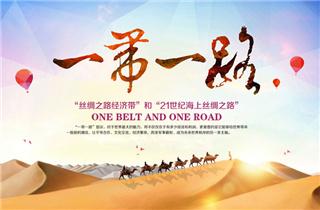Three years ago, President Xi Jinping put forward the strategic conception of building the "Silk Road Economic Belt" and "21st Century Maritime Silk Road", known shortly as the "One Belt and One Road" initiatives. The proposal garnered the interest of the global community, as soon as it was announced. Various countries along the proposed route have expressed broad support, while domestic cities and provinces, which were part of the ancient Silk Road, have welcomed the idea.
This visionary conception that leverages on China's historical connections has created a new opportunity to rejuvenate the economic and cultural ties built via the ancient Silk Road. It presents a "win-win approach" to peaceful coexistence and mutual development. The idea carries forward the spirit of the ancient Silk Road that was based on mutual trust, equality and mutual benefits, inclusiveness and mutual learning, and win-win cooperation.
It also conforms to the 21st century norms of promoting peace, development, cooperation and adopting a win-win strategy for all. The conception organically links the "Chinese dream" to the "Global Dream" and has far-reaching strategic significance with a global impact.
Once the "One Belt, One Road" vision is realized, it would create the most promising economic corridor, directly benefiting a population of 4.4 billion people or 63 percent of the global population, with a collective GDP of 2.1 trillion U.S. dollars that accounts for 29 percent of the world's wealth. The related region, which is the most dynamic and vibrant economically, encompasses many developing countries with emerging market economies and a big growth potential. Most of these countries also have a late-mover advantage, which provides large room for development. China already has close economic and trade cooperation with the related countries along the proposed route, accounting for a quarter of China's total foreign trade. The annual trade between China and these countries has grown by 19 percent on average in the past decade.
The joint efforts by China and the countries connected to the 'One Belt and One Road' vision has made rapid progress, especially in the fields of transportation, infrastructure development, trade and investment, energy and natural resources and in promoting financial security and advancing bilateral and regional cooperation.
First of all, China has made headway via the ASEAN Ten Plus One arrangement, the Shanghai Cooperation Organization, the BRICS countries, and solidified bilateral ties with Russia and countries in Central Europe, Central Asia the Middle East and South Asia. A bilateral, regional, and multilateral cooperation mechanism between China and the countries along the proposed route has been established preliminarily in either a fixed or non-fixed manner.
Secondly, the vision for a 'One Belt and One Road', allows the countries involved to create a three-dimensional and multi-layer transport network that connects them via land, sea and air. That includes the New Eurasian Continental Bridge, which is regarded as the 'modern Silk Road', the China-Singapore Economic Corridor that runs through the Indo-China Peninsula and the Bangladesh-China-India-Myammar Economic Corridor that connects China to South Asia. The prototype of a backbone passage for the One Belt and One Road vision has emerged.
Thirdly, several financing platforms such as an Asian interconnection and mutual communication investment bank, the Shanghai Cooperation Organization development fund and the Shanghai Cooperation Organization development bank are being planned to finance these ambitious infrastructure development projects.
Fourthly, different logistics hubs are being built across the region to support the 'One Belt and One Road' initiatives. Several free-trade industrial parks have also sprung up that would help to connect the production, circulation and marketing of goods in the region. The eventual economic dividends of the 'One Belt and One Road' vision are expected to bring about shared economic prosperity that will help promote social progress, political stability and overall security in the region.

评论列表 ( 0 )